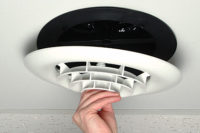
Supplying more educational selling tools to contractors, manufacturers took advantage of the small replacement rush created by the tax incentives in the American Recovery and Reinvestment Act of 2009. (Photo courtesy of Trane.)
A manufacturer’s job is more than putting together pieces and creating new products, especially when economic stability is questionable. Charged with watching trends, meeting high standards, and preparing the industry to understand, install, and repair diverse equipment, HVACR manufacturers continued to meet the challenges set before them last year and are fixing vigilant eyes on the future of their equipment and customers.
GREEN EDUCATION AND MARKETING
Last year, as slowing cash flows and equipment replacement hesitation grew, manufacturers turned to customer education. Supplying more educational selling tools to contractors, manufacturers took advantage of the small replacement rush created by the tax incentives found in the American Recovery and Reinvestment Act of 2009 (ARRA). The focuses of these selling tools were energy efficiency and sustainability.“Green has been the standard operating procedure at Johnson Controls long before we called it green,” said Andy Armstrong, Johnson Controls Inc. “That being said, we continue to engineer, manufacture, apply, market, and sell our products with a focus on sustainability.”
According to the company, its educational sales tools focus on educating rather than selling homeowners, a trend becoming more evident as mass amounts of readily available information increases. Crossing the standard selling borders, Johnson Controls ventured into new media, creating 13 flash videos to help homeowners understand the value of greater efficiency.
“We have provided each dealer the ability to build a brochure with his local energy rates and design temperatures to calculate more accurate cost estimates for his homeowner customers,” explained Armstrong. “With better information, homeowners can make better decisions for themselves and for the environment.”
Johnson Controls wasn’t the only manufacturer placing great emphasis on education and training. Nordyne launched a consumer and contractor education program on the benefits of installing hybrid systems.
“Technology has made these systems much easier to install today compared to the dual-fuel technology available a decade ago,” said Carol Baker, vice president of marketing, Nordyne. “Just a few weeks ago, we launched a Website to help consumers find state information on the cash-for-appliance rebate programs that apply to HVAC products.”
Trane put considerable effort into training as well. Launching the Trane Comfort Specialist program, the manufacturer provided its dealers with full marketing, advertising, product, and sales leads advantages.
TRAINING FACILITIES
HVACR education and training go hand-in-hand, and LG Electronics made a concerted push into the training arena last year. Offering what is still considered non-traditional heating and cooling solutions, the company focused on the application, design, and installation training for duct free and variable refrigerant flow HVAC systems.“We are growing our training team, as well as our number of training facilities in order to meet the demand for hands-on training environments,” said Kelly Cutchins, vice president, Commercial Air Conditioning, LG Electronics. “Our growth is heavily dependent upon our ability to attract new talent and to effectively train new customers on our technology. Our plan is to grow the organization with qualified, effective people and to invest in new training facilities throughout 2010.”
COUNTERFEIT PRODUCTS
The overall industry continues to face troubles arising from counterfeiters, especially in the components and controls sector, according to Richard Foster, president of Zonefirst. And, according to Nordyne, foreign manufacturers are becoming bigger players in the U.S. appliance industry and, “it is natural to assume that it is just a matter of time when the focus shifts to the HVAC market.”The company cited strict standards and more complex HVAC systems as reasons slowing the counterfeit production of HVACR products. “Refrigerant and performance standards may be keeping foreign competitors at bay today, but no manufacturer is going to underestimate the threat they pose to domestic sales,” said Baker.
The key for Johnson Controls in alleviating some of the counterfeit pressure is awareness.
“As a global company, we are very aware of competition both locally and abroad,” explained Armstrong. “We have been tracking changes and feel there is still a great amount of opportunity here in the United States, as well as our markets abroad.”
COMING CONCERNS
HVACR manufacturers continue to skillfully deal with the challenges facing the industry, but in their success, they don’t forget to keep an eye on the horizon while strategizing ways to deal with upcoming matters such as regional standards and economic uncertainty. “One main issue manufacturers will face over the next five years is continuing to keep up with ongoing code changes in the industry,” said Cutchins. “Staying compliant will be key to being competitive.”Economic uncertainty is not a manufacturer-exclusive concern. Knowing this, James Mash, president and CEO of Purafil Inc., made aggressive corrections to his business in 2009, to position the company for revenue growth in 2010. “Unfortunately, higher growth in margin assumes the 2010 economy doesn’t decline,” said Mash. “We are keeping an eye on the degradation of product quality occurring across the global economy. Many global consumers are forced to buy based only on price in this economy.”
Along with these two main concerns, some manufacturers are also considering the effects of extended lead times from suppliers, cost control efforts, new refrigeration standards, financing, sales, taxes, and government regulations.
Overall, the industry is looking at 2010 for economic growth as it prepares to meet the challenges ahead. HVACR manufacturers are doing much the same.
Publication date:03/15/2010


